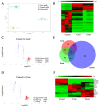Unlocking the Potential of Camel Milk-Derived Exosomes as Novel Delivery Systems: Enhanced Bioavailability of ARV-825 PROTAC for Cancer Therapy
- PMID: 39204415
- PMCID: PMC11359469
- DOI: 10.3390/pharmaceutics16081070
Unlocking the Potential of Camel Milk-Derived Exosomes as Novel Delivery Systems: Enhanced Bioavailability of ARV-825 PROTAC for Cancer Therapy
Abstract
This study investigates the use of camel milk-derived exosomes (CMEs) as carriers for ARV-825, an anticancer agent targeting bromodomain-containing protein 4 (BRD4), in oral chemotherapy. CMEs were isolated and characterized, and ARV-825-loaded CME formulations were prepared and evaluated through various in vitro and in vivo tests. The ARV-825-CME formulation exhibited an entrapment efficiency of 42.75 ± 5.05%, a particle size of 136.8 ± 1.94 nm, and a zeta potential of -32.75 ± 0.70 mV, ensuring stability and sustained drug release. In vitro studies showed a 5.4-fold enhancement in drug release kinetics compared to the free ARV-825 solution. Permeability studies indicated a 3.2-fold increase in apparent permeability, suggesting improved cellular uptake. Cytotoxicity assays demonstrated potent anticancer activity, with IC50 values decreasing by 1.5 to 2-fold in cancer cell lines SF8628 DIPG and H1975R (resistant to Osimertinib). In vivo pharmacokinetic studies in Sprague-Dawley rats revealed superior systemic absorption and bioavailability of ARV-825 from CMEs, with a 2.55-fold increase in plasma concentration and a 5.56-fold increase in AUC. Distribution studies confirmed absorption through the ileum. This research highlights the potential of CMEs as a promising delivery platform for ARV-825, enhancing its therapeutic efficacy and offering a novel approach to cancer treatment.
Keywords: ARV-825; anticancer; camel milk exosomes; oral bioavailability.
Conflict of interest statement
The authors declare no conflicts of interest.
Figures







References
-
- CDC CDC Works 24/7. Centers for Disease Control and Prevention. [(accessed on 11 February 2024)]; Available online: https://www.cdc.gov/budget/documents/covid-19/cdc-247-response-to-covid-....
-
- Research and Development in the Pharmaceutical Industry Congressional Budget Office. [(accessed on 20 June 2024)]; Available online: https://www.cbo.gov/publication/57126.
Grants and funding
LinkOut - more resources
Full Text Sources

